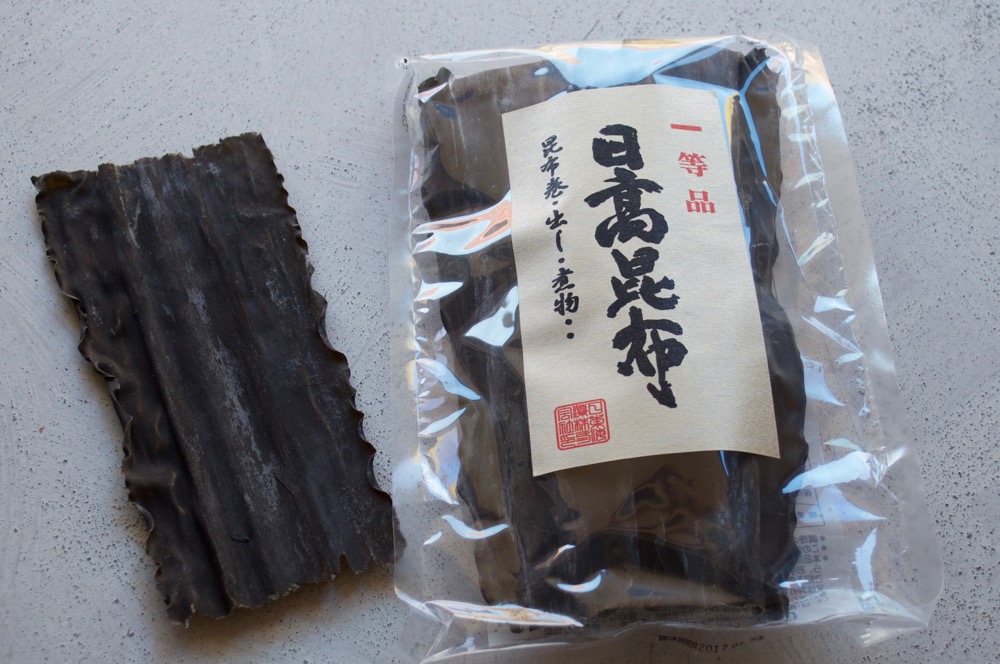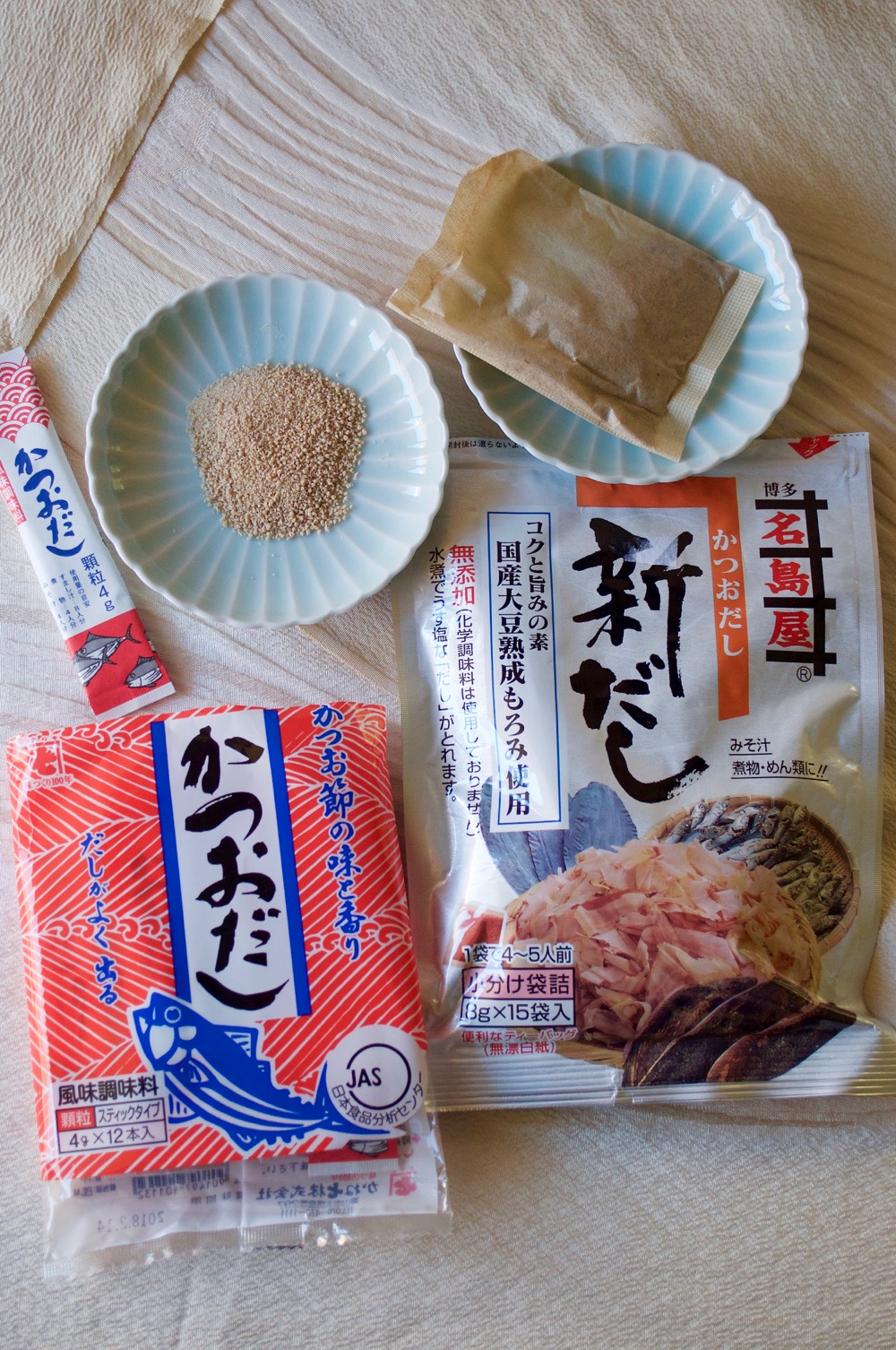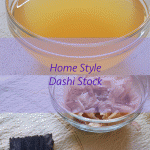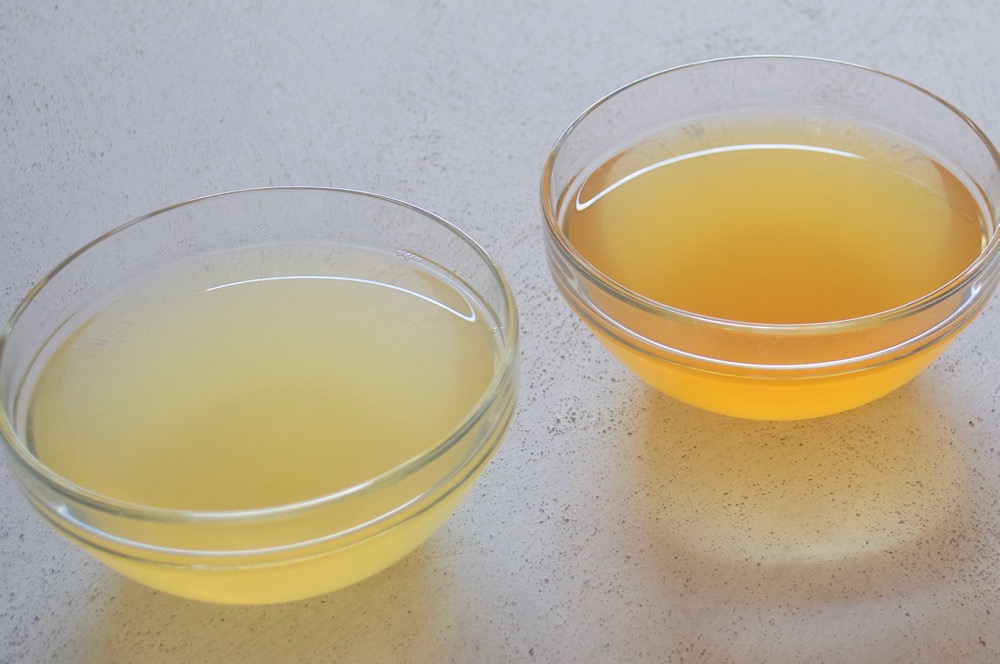In this recipe, I will show you how to make the commonly used method of making Japanese dashi stock for home cooking. It is quite simple to make and flavour is no comparison to the instant dashi seasoning.

Depending on the dishes you make, you use different kinds of dashi (出汁) stock as seen in the list below.
Main varieties of Japanese dashi stock
- Awase-dashi (合わせ出汁) – made from katsuobushi (鰹節, dried bonito flakes) and konbu (dried kelp)
- Katsuo-dashi (鰹出汁) – made from katsuobushi (鰹節, dried bonito flakes) only
- Konbu-dashi (昆布出汁) – made from konbu (昆布, dried kelp)
- Niboshi-dashi (煮干し出汁) – made from niboshi (煮干し, dried small sardines/anchovies)
- Shiitake-dash (椎茸出汁) – made from dried shiitake (椎茸) mushrooms
In the case of awase-dashi and katsuo-dashi, you can get dash stock twice from the same ingredients. The first dashi stock is called ichiban-dashi (一番出汁) and the second stock, which is made by reusing the same dashi ingredients, is niban-dashi (二番出汁). Please visit Varieties of Dashi Stock for the recipes of the dashi stocks listed above.
I like awase-dashi the most as it has the best flavour. But I often make katsuo-dashi because konbu is quite expensive and often I do not have konbu in my pantry. Dashi made with just katsuobushi still has great flavour.
About Katsuobushi
Dried bonito flakes are shavings of dried bonito. Dried bonito itself is actually known as katsuobushi and it comes as a block of dried bonito meat. Bonito flakes themselves have a real name: kezuribushi (削り節). But these days, people use katsuobushi to mean dried bonito flakes as well and I certainly do so. You can buy dried bonito flakes in large or small packets at Asian grocery stores.
In Japan, you can also buy a block of dried bonito meat and shave it yourself using a special bonito shaver. This device is a box with a drawer and has a sharp plane on top. You draw the bonito block across the plane to create shavings which then collect in the drawer.
I used to shave dried bonito when I was a child. It was one of children’s chores, as pre-shaved dried bonito was not sold at the time. I hated shaving the bonito block when it became very small because it is fiddly. But I worked hard so that I would be allowed to chew the little left-over block when it became too small to shave.
You might find the bonito flakes amongst different packet brands may have a slightly different appearance. The differences are usually due to the way they are shaved, or different parts of the bonito block and also quality of the dried bonito. But any of them are just fine to use.

You can buy katsuobushi at Asian grocery stores. they come in either small packets or in a large pack. Texture and colour of shaved katsuobushi can vary depending on the brand as seen in this photo.
About Konbu
If you live in Australia, you might find that Japanese grocery shops do not sell konbu. This is due to Australian quarantine restrictions as they believe konbu contains high Iodine. But you can get konbu in Korean grocery shops. If you ever travel to Japan, make sure that you bring many packets of konbu as qaurantine restrictions are only for commercial importation.
In Japan, about 90% of konbu comes from Hokkaido (northern most of Japan’s main islands). And konbu is sold in a packet indicating where within Hokkaido it is from.
My konbu pack in the photo below says it is from Hidaka which is the southern coast of Hokkaido. Depending on which area of Hokkaido seas it came from, the appearance, texture and flavour of konbu are different. Some are softer than others and some have stronger flavour.

Konbu in a pack and a piece of konbu. It’s about 8-10cm width. Some are cut into 15 cm like this piece, some are just folded and dried to fit in the pack. Use scissors to cut into required length.
Professionals use different types of konbu for different purposes but for home cooking, any kind of konbu should be fine in my view.
You will find that white powder is stuck on the surface of konbu. It is not dust but umami which surfaces when moisture from konbu evaporates. So DO NOT scrape off the white powder.
About Dashi Stock Pack
While you can make Japanese dashi stock from scratch like in my recipes, there are also more convenient ways to make dashi using prepared products. You can buy Japanese dashi stock packs or dashi seasoning at Asian or Japanese grocery stores, perhaps even at super markets.
Japanese dashi stock pack comes in a sachet containing finely shaved bonito flakes. You place a pack in water and boil to infuse umami from the bonito fakes. Dashi seasoning comes as tiny grains in a bottle or packet. You simply add it to hot water or boiling water and stir.
Japanese dashi stock packs use real bonito flakes so it does not lose authenticity of flavour and you could get pretty good dashi out of it. Dashi seasoning is more artificial and less authentic as it is a granular bonito-flavoured seasoning (but still tastes good). I use them when I only need a small amount of dashi or I am in a hurry — which is often the case.

Left half: Dashi seasoning pack and granular bonito-flavoured powder in each sachet. Right half: Dashi stock pack and finely shaved katsuobushi in a sachet.
Naturally, the Japanese dashi stock pack is much better than the dashi seasoning. If the key feature of the dish is the dashi flavour such as osuimono (お吸い物, clear soup), I make dashi from scratch. Also, the dashi seasoning contains salt already so you have to take that into account when adding salty seasonings in a recipe such as soy sauce.
I thought it might be best to introduce a recipe which is a general purpose method for making dashi at home. This method is not listed in my other post Varieties of Dashi Stock. The method in that post includes the professional method of making dashi.
But you would only make dashi in the professional way if you entertain people regularly with Japanese food. Even most households in Japan do not use the professtional method. So, here is instead how most households make dashi stock. This is what I call “Home Style Japanese Dashi Stock”.
Yumiko![]()

- 500 ml water
- 5cm (2") x 5cm (2") strip of konbu (dried kelp)
- 15g (0.5oz) katsuobushi (dried bonito flakes)
-
Gently wipe any dust off konbu if necessary using dry towel or paper towel. Do not wash or remove white powder stuck on the surface of konbu by scraping it off as it is the umami (旨味).
-
Add the water in a pot and soak the konbu for about 30 minutes if you have time. If you don’t have time, don’t worry.
-
Place the pot over medium heat. When small bubbles start appearing in the pot, reduce heat to minimum and cook for about 10 minutes.
-
Add katsuobushi and turn the heat up to medium. Cook for about 10 minutes.
-
Turn the heat off and wait until katsuobushi sinks to the bottom of the pan.
-
Line a few layers of muslin or a paper towel over in a sieve and pour all the contents in the pan to into the sieve. Let it drain naturally, lightly squeezing the katsuobushi (Note 1).
1. Do not squeeze the katsuobushi too hard as it will produce a slight bitterness.
2. You cannot keep dashi very long even in the fridge as it loses flavour. 2-3 days is the max, I would think. Freezing will also lose the falvour but if you don’t mind losing it, you could freeze the stock.
3. If you would like to make dashi from store bought dashi pack or seasoning, just follow the instructions on the packet which should tell you how much you need for certain amount of water.

Thanks for making your site! I don’t really like fish and most of my family is vegetarian and I am so happy I found this website so I can try and authentic Japanese food, that is vegetarian as well.
Hi Kiren, welcome to RecipeTin Japan!
Been looking for an easy to understand Japanese cooking.
I need to mak dashi for okonomiyagi.
Thankyou
Hi Marianne, good luck with Okonomiyaki!
Hi! I’ve made Alton Brown’s miso soup recipe several times and I really like it…I was curious as to how “authentic” it was and it seems it’s pretty close.
I’m so glad I found your website, I am REALLY looking forward to making all of the wonderful looking recipes I’ve seen here so far!
Thank you for sharing!!
-Daniel
Hi Daniel, thank you and welcome! Feel free to ask questions if you have.
Hi, do you buy most of your Japanese froceries fro Tokyo Mart? I find them a bit more expensive.
Hi there, only if I could find food at Tokyo Mart, I go there. I also go to Anegawa Japanese grocery store in Artarmon on Elizabeth street, very close to the station. But I try to buy groceries in Asian grocery stores where possible.
My daughter is very interested in trying to cook Japanese food. Thank you for this wonderful resource!
Hi Teresa, you are welcome. Happy to be of your daughter’s help!
Your site is simply great. I am happy to have found this site. I wanted to make the Japanese cuisines I enjoyed when I visited Japan some years back. And you have done well to simplify the recipes.
I will make the ones I can find the ingredients in my country Nigeria.
Thank you
Hi Victoria, thank you! If you like a recipe but cannot fine one or two ingredients, feel free to ask me. There might be alternatives.
Hi I always use only konbu dasi but I will try dasi made buy kathuobusi.
Thank you!
Also where did you buy light blue plates? They are so pretty.
Hi Soo, I think I bought these light blue plates in Japan.
I know it won’t be the same, but is there something I could sub in for the bonito flakes as I’m a vegetarian.
Thanks!
Hi Becca, you can use vegetarian dashi stock which are made from either konbu (kelp) or shiitake mushrooms. They are called ‘konbu-dashi’ and ‘shiitake-dash’ respectively. Please visit my post, Variety of Dashi Stock (https://japan.recipetineats.com/varieties-of-dashi-stock/) and see the details of how to make it.
In most cases, I would recommend that you use konbu-dashi but if the dish includes mushrooms as one of the key ingredients, I would use shiitake-dashi.
You could also buy konbu-dashi powder (or in granular form) which you dilute in water to make konbu-dashi. They are sold at Japanese and possibly Asian grocery stores. You could also buy it on Amazon – search on ‘konbu dashi powder’).
Thank you Yumiko! I have a great Asian grocery store nearby and was able to find the kombu-dashi. I must say, I was skeptical that plain water would take on that much flavour in just 3 hours, but it does! It’s so delicious! I used it to make your Zaru Soba dish and it was soooooo good!!! I’ve always loved soba, but never tried it like this– letting the soba really shine– and the dipping sauce is such a wonderful accompaniment! I really appreciate the background and etiquette info you provide as well: it felt so good to slurp happily away and know that not only am I not doing anything wrong, I should be doing it! Thank you for sharing yohr amazing recipes and advice!
Any tips on a recipe I should try to use up my leftover dashi (I’m vegetarian). I made a double batch.
Becca 🙂
Hi Becca, if you click ‘Recipe Index’ in the menu, you will find ‘Vegetarian’ category. Some of them do not use dashi stock but there are some dishes with which you can cook vegetarian dashi stock, e.g. mixed rice (gomoku gohan, daikon gohan), sauce for agedashi tofu, gomoku name, etc. Even tempura dipping sauce can be made with konbu dashi and make vegetarian tempura. What about miso soup? You can make miso soup with lots of vegetables – see my Tonjiru recipe, omit pork and use konbu dashi.
Found this via my mail sub at Recipe Tin Eats. What attracted me is the JN cooking as years back I lived in Japan while in the Military. I had the fondest memories of living in the country and eating so many new foods. Especially late nights with my Japanese girlfriend at the time eating “real” Ramen noodles at hidden back alley ways in Tokyo district and in Yokohama. I ate lots of Japanese food that gave variety to my palette. So it’s so nice to see a slick, clean Japanese Food Blog in English and also as an offshoot of Recipe Tin Eats incredible recipes. So glad you did the several series posts on Miso Soups, it was and still remain a favorite. Will surely be hanging around, maybe I learn to cook a few more dishes.
Hi Urban,
Thanks for sharing your wonderful memory of living in Japan and eating great food. I love ramen, too. I must eat ramen from time to time even in Sydney. When I go back to Japan, I make sure that I eat ramen a couple of times while I am there. I am intending to post a different kind of miso soup with lots of ingredients in it some time later. So watch the space!
I enjoy this site – its so usefull and helpfull
Hi, I am glad that it’s useful.
I love this site . It’s simple and I really learn to cook Japanese meals which I love
Zeny126@ yahoo
Thank you!